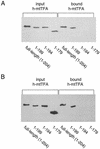Human mitochondrial transcription factor B1 interacts with the C-terminal activation region of h-mtTFA and stimulates transcription independently of its RNA methyltransferase activity
- PMID: 12897151
- PMCID: PMC166325
- DOI: 10.1128/MCB.23.16.5816-5824.2003
Human mitochondrial transcription factor B1 interacts with the C-terminal activation region of h-mtTFA and stimulates transcription independently of its RNA methyltransferase activity
Abstract
A significant advancement in understanding mitochondrial gene expression is the recent identification of two new human mitochondrial transcription factors, h-mtTFB1 and h-mtTFB2. Both proteins stimulate transcription in collaboration with the high-mobility group box transcription factor, h-mtTFA, and are homologous to rRNA methyltransferases. In fact, the dual-function nature of h-mtTFB1 was recently demonstrated by its ability to methylate a conserved rRNA substrate. Here, we demonstrate that h-mtTFB1 binds h-mtTFA both in HeLa cell mitochondrial extracts and in direct-binding assays via an interaction that requires the C-terminal tail of h-mtTFA, a region necessary for transcriptional activation. In addition, point mutations in conserved methyltransferase motifs of h-mtTFB1 revealed that it stimulates transcription in vitro independently of S-adenosylmethionine binding and rRNA methyltransferase activity. Furthermore, one mutation (G65A) eliminated the ability of h-mtTFB1 to bind DNA yet did not affect transcriptional activation. These results, coupled with the observation that h-mtTFB1 and human mitochondrial RNA (h-mtRNA) polymerase can also be coimmunoprecipitated, lead us to propose a model in which h-mtTFA demarcates mitochondrial promoter locations and where h-mtTFB proteins bridge an interaction between the C-terminal tail of h-mtTFA and mtRNA polymerase to facilitate specific initiation of transcription. Altogether, these data provide important new insight into the mechanism of transcription initiation in human mitochondria and indicate that the dual functions of h-mtTFB1 can be separated.
Figures






Similar articles
-
Relative abundance of the human mitochondrial transcription system and distinct roles for h-mtTFB1 and h-mtTFB2 in mitochondrial biogenesis and gene expression.Nucleic Acids Res. 2007;35(12):4042-54. doi: 10.1093/nar/gkm424. Epub 2007 Jun 8. Nucleic Acids Res. 2007. PMID: 17557812 Free PMC article.
-
Evidence for an early gene duplication event in the evolution of the mitochondrial transcription factor B family and maintenance of rRNA methyltransferase activity in human mtTFB1 and mtTFB2.J Mol Evol. 2006 Nov;63(5):707-17. doi: 10.1007/s00239-006-0075-1. Epub 2006 Oct 6. J Mol Evol. 2006. PMID: 17031457
-
Human mitochondrial ribosomal protein MRPL12 interacts directly with mitochondrial RNA polymerase to modulate mitochondrial gene expression.J Biol Chem. 2007 Apr 27;282(17):12610-8. doi: 10.1074/jbc.M700461200. Epub 2007 Mar 2. J Biol Chem. 2007. PMID: 17337445 Free PMC article.
-
Initiation and beyond: multiple functions of the human mitochondrial transcription machinery.Mol Cell. 2006 Dec 28;24(6):813-25. doi: 10.1016/j.molcel.2006.11.024. Mol Cell. 2006. PMID: 17189185 Review.
-
Mitochondrial transcription factor A (mtTFA) and diabetes.Diabetes Res Clin Pract. 2001 Dec;54 Suppl 2:S3-9. doi: 10.1016/s0168-8227(01)00330-8. Diabetes Res Clin Pract. 2001. PMID: 11733104 Review.
Cited by
-
Control of mitochondrial transcription specificity factors (TFB1M and TFB2M) by nuclear respiratory factors (NRF-1 and NRF-2) and PGC-1 family coactivators.Mol Cell Biol. 2005 Feb;25(4):1354-66. doi: 10.1128/MCB.25.4.1354-1366.2005. Mol Cell Biol. 2005. PMID: 15684387 Free PMC article.
-
Maintaining ancient organelles: mitochondrial biogenesis and maturation.Circ Res. 2015 May 22;116(11):1820-34. doi: 10.1161/CIRCRESAHA.116.305420. Circ Res. 2015. PMID: 25999422 Free PMC article. Review.
-
Human mitochondrial transcription revisited: only TFAM and TFB2M are required for transcription of the mitochondrial genes in vitro.J Biol Chem. 2010 Jun 11;285(24):18129-33. doi: 10.1074/jbc.C110.128918. Epub 2010 Apr 21. J Biol Chem. 2010. PMID: 20410300 Free PMC article.
-
Architectural role of mitochondrial transcription factor A in maintenance of human mitochondrial DNA.Mol Cell Biol. 2004 Nov;24(22):9823-34. doi: 10.1128/MCB.24.22.9823-9834.2004. Mol Cell Biol. 2004. PMID: 15509786 Free PMC article.
-
Ataxia-telangiectasia mutated kinase regulates ribonucleotide reductase and mitochondrial homeostasis.J Clin Invest. 2007 Sep;117(9):2723-34. doi: 10.1172/JCI31604. J Clin Invest. 2007. PMID: 17786248 Free PMC article.
References
-
- Bogenhagen, D. F. 1996. Interaction of mtTFB and mtRNA polymerase at core promoters for transcription of Xenopus laevis mtDNA. J. Biol. Chem. 271:12036-12041. - PubMed
-
- Bussiere, D. E., S. W. Muchmore, C. G. Dealwis, G. Schluckebier, V. L. Nienaber, R. P. Edalji, K. A. Walter, U. S. Ladror, T. F. Holzman, and C. Abad-Zapatero. 1998. Crystal structure of ErmC′, an rRNA methyltransferase which mediates antibiotic resistance in bacteria. Biochemistry 37:7103-7112. - PubMed
Publication types
MeSH terms
Substances
Grants and funding
LinkOut - more resources
Full Text Sources
Other Literature Sources
Molecular Biology Databases
